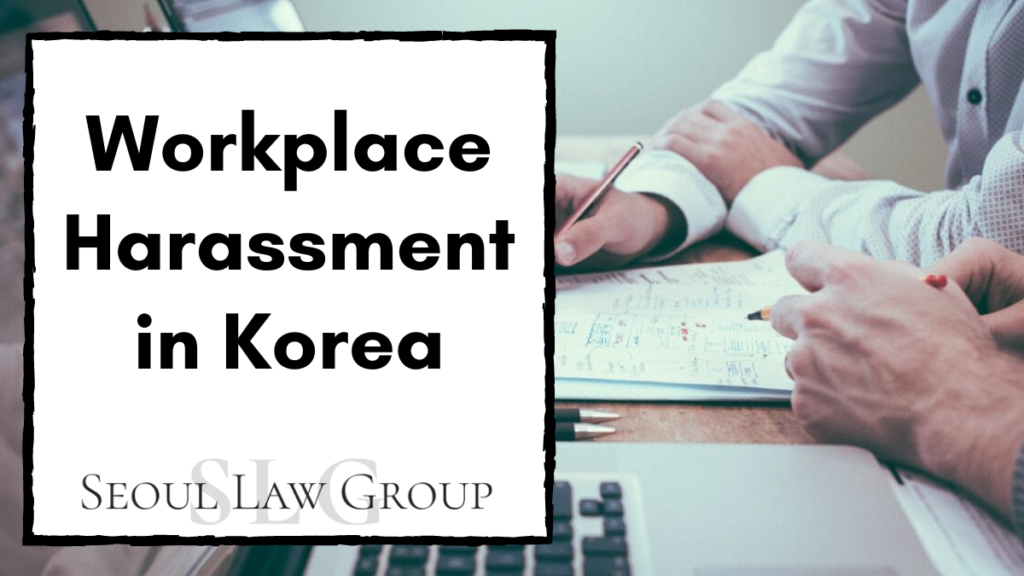Labor Standard Act, Article 76-2, prohibits “workplace harassment” and also sets its definition.

Article 76-2 (Prohibition against Workplace Harassment)
No employer or employee shall cause physical or mental suffering to other employees or deteriorate the work environment beyond the appropriate scope of work by taking advantage of superiority in rank, relationship, etc. in the workplace (hereinafter referred to as “workplace harassment”).
According to this article, there are three requirements that should be met in order to recognize a certain behavior as “workplace harassment.”
One, “by taking advantage of superiority.” The perpetuator should be superior to the victim in any way (in rank, seniority, personal connection, social influence, etc.), and take advantage of their own superiority to harass the victim.
Two, “beyond the appropriate scope of work.” The harassment should occur in a work-related situation, and it should be beyond the appropriate scope. It can’t be “workplace harassment” if the incident occurred in a personal situation unrelated to work.
Three, “causing physical or mental suffering to other employees or deteriorating the work environment.”
This is the list that Ministry of Employment and Labor showed as examples of workplace harassment.:
- Not recognizing or even mocking the victim’s job skills or performance without justifiable reasons.
- Discrimination in training, promotion, reward, daily treatment, etc. without justifiable reasons.
- Repeatedly assigning difficult tasks everyone doesn’t want (which are not written in the contract) to a specific victim, unlike other employees.
- Only giving odd jobs that are not written in the contract, or giving very little work to the victim.
- Not providing important information related to work or excluding the victim from the decision-making process without justifiable reasons.
- Pressuring the victim to not use their vacation, sick leave, other various welfare benefits, without justifiable reasons.
- Excessively monitoring the victim’s working or resting, unlike other employees.
- Continuously and repeatedly asking the victim to do works related to the perpetrator’s personal life, such as running private errands.
- Forcing the victim to move or leave the department without justifiable reasons.
- Spreading the victim’s personal stories or rumors behind their back.
- Physical threat or violence.
- Swearing or intimidating words.
- Making insulting remarks to the victim in front of other people or online.
- Forcing the victim to participate in drinking, smoking, or other gatherings regardless of their own opinion.
- Group bullying.
- Not providing major equipment (computer, telephone, etc.) necessary for the work, or blocking the victim’s access to the Internet or in-house network.
These are the lists of cases that were actually reported and recognized as workplace harassment.
- The perpetuator planned to bully the victim and eventually drive her out from the company. So, after the victim got back from her maternity leave, they gave her less important work from before, got rid of her desk, and made insulting remarks, which made her quit the job as a result.
- The perpetuator demanded the victim to throw a party or they would give the victim disadvantages, constantly saying things like “Hurry and just do it” “You still haven’t set a date?” “Submit a report of the reason why you can’t do it” “You should use 30% of your bonus to entertain your superiors.”
- The perpetuator (employer) constantly abused the victim (personal driver), by constantly yelling, berating, or even hitting the victim’s head from the backseat. Once the perpetuator forced the victim to drive without a room mirror and side-view mirrors, causing extreme stress.
- The perpetuator constantly demanded the victim to run his private errands, such as cleaning the snow from his wife’s car, or tending his vegetable garden, even though these things are not related to the victim’s job at all.
Please note that “workplace harassment” in Korea does NOT include sexual harassment, unlike many other countries. If the case is a sexual harassment, it would be handled according to the Equal Employment Opportunity and Work-Family Balance Assistance Act, Article 12.
Article 12 (Prohibition of Sexual Harassment in Workplace)
No employer, superior, or employee shall commit any sexual harassment in the workplace against another employee.


Who can I contact about workplay bullying?
Who can I contact about work place bullying?
Please reach out to use by email with more info about your case. Thank you
I heard that in Korea if workplace harassment is established, the employer will be fined but the worker does not receive compensation. Is this correct?
What if an employee is facing workplace harassment and that person approaches the law firm to help them out, how does the law firm exactly take on the case?
To see through this, if we say this is a crime then how is the harasser punished?
(this comment was not meant to offend anyone, but in case if it did I sincerely apologies)
Wow, incredible weblog layout! How long have you ever been blogging for? you made running a blog look easy. The full look of your web site is wonderful, let alone the content!
Thank you for your kind words! We’ve been running this blog for several years now, and we’re delighted that you find it visually appealing and valuable. Our aim is to provide informative and helpful content. We appreciate your support!
Please let me know if you’re looking for a article writer for your site. You have some really great articles and I believe I would be a good asset. If you ever want to take some of the load off, I’d absolutely love to write some articles for your blog in exchange for a link back to mine. Please send me an email if interested. Many thanks!
Thank you for reaching out and offering your writing services. While we appreciate your interest, we currently do not have any plans to engage additional writers for our blog.